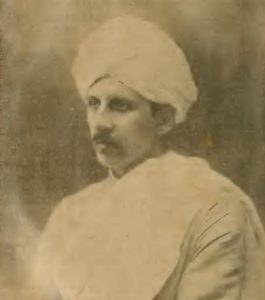Ananda Coomaraswamy remains one of the most staunch defenders of the Indian tradition in the mold of what David Frawley calls an intellectual kshatriya. Coomaraswamy wrote a series of articles about the state of (the British-imposed) Indian education and alerted Indians about its perils.
Ananda Coomaraswamy mostly wrote for a scholarly audience, so he didn’t quite use the forthright language that Swami Vivekananda did:
The child is taken to school, and the first thing he learns is that his father is a fool, the second thing that his grandfather is a lunatic, the third thing that all his teachers are hypocrites, the fourth, that all the sacred books are lies!… We have learnt only weakness.
Coomaraswamy enunciated the nuances behind what the Swami expounded to an ostensibly lay audience. One of the most celebrated quotes of Coomaraswamy on the disasters of English education follows:
A single generation of English education suffices to break the threads of tradition and to create a nondescript and superficial being deprived of all roots—a sort of intellectual pariah who does not belong to the East or the West, the past or the future. The greatest danger for India is the loss of her spiritual integrity. Of all Indian problems the educational is the most difficult and most tragic.
His essay, Education in India is a reader’s treat in the range of problems it examines, equally the solutions it suggests. Read together with Memory in Education, it shows what was and what is possible.
Coomaraswamy opens the first essay with his characteristic candor in condemning the more evil facets of British imperialism: "…[One of] the greatest injuries done to the people of India have taken the outward form of blessings."
The perception that British education somehow “liberated” India persists till date. Manmohan Singh not long ago stated something to the effect as do several English-educated middle class Indians. Coomaraswamy demolished the myth in 1909 when he wrote this piece. In his time, he noted that an average English-educated Indian was unable to appreciate, nay, understand his own culture.
The most crushing indictment of this Education is …that it destroys …all capacity for the appreciation of Indian culture. Speak to the ordinary graduate… on the ideals of the Mahabharata–he will hasten to display his knowledge of Shakespeare; talk to him of religious philosophy–you find that he is an atheist of the crude type common in Europe a generation ago…not only has he no religion but he is as lacking in philosophy as the average Englishman…talk to him of Indian art–it is news to him that such a thing exists; ask him to translate…a letter written in his own mother tongue–he does not know it. He is indeed a stranger in his own land.
The last line is in itself a crushing indictment of our collective cultural amnesia. Coomaraswamy reserves strong words for Lord Macaulay, the man who started this process of cultural colonization. Addressing the British educators in a tone of undisguised sarcasm, he asks them why they’re unable to recognize the Indian babu, “made in [their] own image” by their "…most pompous and self-important philistine, Lord Maculay, [who believed that] a single shelf of a good European library was worth all the literature of India, Arabia, and Persia." And sounds an baleful prophecy too: "Beware lest in a hundred years the judgement be reversed."
In small and numerous ways, Coomarswamy’s prediction is slowly ringing true. There’s renewed interest to study ancient India with a zeal like never before. The “New Age” racket is just ancient India crudely, intelligently, attractively, and in some cases, falsely packaged.
British Education Policy Examined
Coomaraswamy’s condemnation of British education stemmed from several sources. His main concern was that English education replaced something valuable with something worthless. It put the student in a paradox: on the one hand the student was cut off from his roots and on the other, he would never be able to fully acquire the culture and/or viewpoint of the imperialist. "…in actual fact, it is not the English point of view [that is acquired] but a caricature of it."
He quotes Abbe Dubois on the subject: "To make a new race of the Hindus, one would have to begin by undermining the very foundations of their civilization, religion, and polity, and by turning them into atheists and barbarians."
And this belief that Indians needed to be educated stemmed from the assumption that India was a savage country, “which it is England’s divine mission to civilize.” It is reasonable to conclude that Macaulay operated from this (racist) mode.
When Macaulay’s infamous Minutes were first put into action, they faced tremendous difficulties as Coomaraswamy points out. Sir Thomas Munro wrote that “if civilization were to be made an article of commerce between two countries, England would soon be heavily in debt.” Prof. Nelson Fraser “shows how little the English teacher can know of the real life of [Indians]…” and "The Englishman is the last person to put forward any view as to possible reforms in Hindu institutions."
Coomaraswamy also narrates how the English educators who arrived in India to teach were completely lost. In their sincere attempts to know more about Indians, they find that the more “[the teacher] understood, the less would he wish to interfere, for he would either be Indianised at heart , or would have long realized the hopeless divergence” between English and Indian ideals. Coomaraswamy says that the idea of education should be separated from the “notion of altering the structure of Indian society.” Any alteration or change or in his words, “true reforms come only from within and slowly.”
The British however, did not heed any of these problems reported from “the field.” They devised the education system such that Indian ideals, philosophy, arts, and languages were crushed without bloodshed. One way to do that was by bringing education under government control. Ananda Coomaraswamy writes that few indigenous institutions that imparted education in Sanskrit and Arabic “carry on a forlorn struggle for existence.” India had a rich tradition of education built on the gurukula system or pathashala system sponsored by–so to say–the society with little or no adverse government interference. By “governmentalizing” education, the British cut off a long and unbroken tradition almost overnight. Any autonomous institution would die an eventual death.
A few modern institutions such as the Central Hindu College in Benares and the Hardwar Gurukula are carried on entirely without Government aid; but…are bound to the University curriculum as otherwise their students would be unable to obtain degrees… The net result is that Indian culture practically ignored in modern education…
The British attack on Indian education also had the Missionary dimension. Coomaraswamy writes that Missionary education avowedly "…practises intolerance–by endeavouring to destroy that culture, in schools where education is offered as a bribe and where the religion of the people is of set purpose determined." This practice continues even today where some Christian schools forbid female students to wear the bindi, a sacred symbol of Hindus.
Some Solutions
Ananda Coomaraswamy repeatedly stresses on the ideal of education than a mere system of education. As an idea, education should “draw out or set free the characteristic qualities of the taught.”
In Memory in Education, he says that culture “in the East has been only secondarily connected with books and learning; it has been a part of life itself.” From this, it wouldn’t be incorrect to say that culture is the agglomeration of the education of several centuries. That is, any national culture is shaped by the education it receives.
He emphasizes that the “distinction between wisdom and knowledge must never be forgotten,” which reminds us of T.S. Eliot. Wisdom, according to Coomaraswamy is therefore the “true end of education.” He quotes Knox speaking about the culture of the people of Ceylon: "Ordinary Plowmen... do speak elegantly, and are full of compliment... there is no difference between the ability and speech of a Countryman and a Courtier." Coomaraswamy quotes a Sinhalese proverb, "Take a ploughman from the plough and wash off his dirt and he is fit to rule a kingdom," and attributes this astonishing feature to the existence of a national culture not dependent on a knowledge of reading and writing. He laments throughout these essays that this treasure has been lost almost forever thanks to English education. The most visible wound of this is that we have to read our own literature in a foreign language. That the glut of Mahabharatas written today by Indian authors is in English is an admirable effort. Yet almost none of these authors have read the original in Sanskrit–or in their vernacular tongue–because they don’t know the language.
Coomaraswamy offers a seven-point remedy to overcome this. I quote most of them verbatim (in italics).
- A universal philosophical attitude, “contrasting strongly with that of the ordinary Englishman who hates philosophy.”
- The sacredness of all things–the antithesis of the European division of life into sacred and profane… In India…religion idealises and spiritualizes life itself rather than excludes it.
- The true spirit of religious toleration, illustrated continually in Indian history…
- Etiquette–civilization conceived of as the production of civil men. In other words, education should enable a civilization where life should bring forth culture, not books.
- The renewal of the special relationship between teacher and pupil and a return to the epics, classics, and great literature. …the epics as embodying ideals of character, learning [as] a privilege demanding qualifications, not to be forced on the unwilling…extreme importance of the teacher’s personality. Coomaraswamy frowns upon the modern practice of “making everything easy for the pupil.”
- The basis of ethics should spring from altruism and not from–religious or other–commandments. This follows from the “recognition of the unity of all life.”
- Development of personal character and conduct. As educational aids, Coomaraswamy lists them as control of thought, speech and action, concentration, one-pointedness and a “capacity for stillness.”
His essay laments the loss of these ideals, which existed for centuries despite Islamic invasions. However, it was only the British axe that dealt it the death blow.
Coomaraswamy’s criticism might seem severe but he is not blind to some of the advantages the English education brought for India. Even here, he says, these benefits tilt the balance in favor of preserving Indian culture. To close this post in his words: "…Western knowledge is necessary for India, but it must form for her…a post-graduate course."

















































Comments